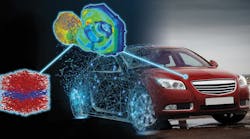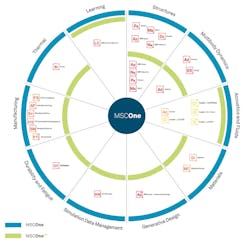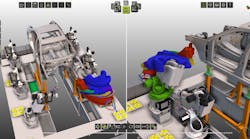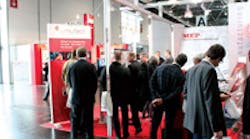Latest from Industry Trends
A perfect storm of new pressures now faces the manufacturing industry. New noise and emissions regulations are driving automotive and aerospace manufacturers to seek new product design and manufacturing methods to create quieter, lightweight, low-carbon vehicles. At the same time, there remains pressure to control short-term costs and develop more agile processes due to the current uncertain global economic climate.
Our customer base spans diverse industries from aerospace to consumer electronics, so we have seen first-hand the pressure to do more with less. In the news, we see that the global lockdown is leading companies such as Airbus and Jaguar Land Rover to curb or cease manufacturing, and shed the jobs associated with it. This exacerbates an already challenging business environment, with carmakers trimming production last year and the aerospace industry canceling aircraft orders, citing revenue loss, and passenger safety concerns.
At the same time, regulations have shaped new imperatives for design and engineering innovation. A traditionally conservative sector, the aviation industry is under huge pressure to meet the conflicting demands for more sustainable travel and shorter journeys. Aviation manufacturing is undergoing a sea-change to profit-focused sustainable design, using lightweight components to boost fuel efficiency and optimizing high-efficiency engines to avoid noise that might exclude them from flying lucrative routes.
Simultaneously, aviation R&D is looking into future mobility, for example using new carbon nanotube-enhanced materials to provide lightweight heat shields for hypersonic aircraft or developing new UAV concepts. Delivering innovation within the context of a struggling aerospace industry with reduced manufacturing budgets presents a major challenge.
The automotive industry is expected to deliver ever higher-spec vehicles, but at the same cost and within a shorter time frame. It took almost thirty years to develop and produce the first mass-market gasoline-powered car, yet automotive OEMs require today’s vehicles to be low-carbon, lightweight, long-range, quiet, connected or autonomous—and all within a much shorter development time, measured in months.
We’ve seen these challenges reflected in the medical sector, too. It is now possible to produce medical devices that are personalized, for example using additive manufacturing methods to print implants based on patient CT scans. But the implementation of this requires new materials and mechatronic design approaches, which are often held back due to complexity and the associated costs.
For certain applications, the design of complex engineered parts must be entrusted to a surgeon who is likely to lack the knowledge needed to take advantage of these techniques.
In every industry, we’ve seen manufacturers face the challenge of adapting to delivering more hi-tech products at a greater rate and at a lower cost than ever before. The upshot is that ‘lean’ product innovation requires the next iteration in lean manufacturing processes. This will mean more integrated and virtual product development workflows and greater collaboration among specialists.
Digitally integrating workflows not only reduces manufacturing delays and costs but also boosts innovation by giving manufacturers the foresight to build ‘first-time right’ products at the design stage.
This kind of end-to-end oversight will spur collaboration across all domains to deliver new innovations adapted to any design objectives or constraints. Rather than designing ‘blue sky’ concepts, this approach would ensure that materials and methods are optimized for everything from cost to carbon efficiency at the design phase so that innovation and efficiency are in lockstep.
This approach enables a manufacturer to accurately predict how different combinations of materials and manufacturing methods will affect everything from the speed to the sustainability of products right at the start of the manufacturing process.
The digital integration of product development from concept to manufacturing will also cut waste by significantly reducing real-world prototyping and over-design. The key to this kind of agility and confidence is Computer Aided Engineering (CAE).
Crucially, CAE must be applied beyond its mechanical design engineering roots to provide knowledge and insights ranging from materials characterization to virtual manufacturing and costing. Simulation software now enables companies to optimize their product designs while ensuring design for manufacture (DfM) alongside every criterion from durability to material utilization to cost to sustainability.
Faster technology cycles and new consumer expectations mean manufacturers must be agile and faster to market with products. Today’s carmakers are having to behave more like consumer electronics manufacturers or even software companies. Some manufacturers are even having to pivot to new markets, as we saw when manufacturers were first tasked with churning out high volumes of medical equipment during the COVID-19 pandemic.
In these situations, having the right simulation tools to make quick assessments of design and production viability enables a business to bid for a new type of contract or support the fight against coronavirus.
The main barrier to this kind of smarter and more agile product development is fragmented product development teams, processes, and disciplines. Many CAE tools are proprietary, yet manufacturers need interoperable tools to pass data easily between workflows so that, for example, acoustics experts can easily read data from mechanical and structures specialists.
Having identified CAE as part of the solution, it’s worth pointing out that a team’s dependence on a single CAE tool can also serve to reinforce rather than remove these divisions. It reduces agility because it prevents an engineer from getting quick access to the right tools. For example, a PCB designer may need to use a tool such as computational fluid dynamics (CFD) on a one-off basis to test the thermal design of a new board within a customer’s enclosure.
Another problem is that new software tools cannot easily be adopted because they require separate license agreements. It inhibits multi-functional collaboration and the simultaneous use of tools across different physics or stages of development. Emerging smart manufacturing workflows are dependent on simulation, but licensing makes it difficult to ‘retrofit’ legacy workflows.
We set out to address these challenges with MSCOne, a product access platform that enables engineers to use any tools in any combination by consuming universal tokens. It also gives access to e-learning through the same tokens, so that engineers can deploy the right mix of tools on a case-by-case basis and learn ‘on the job.’
In the past, all CAE users would be specialists. Think of FEA analysts or multi-body dynamics specialists each working on one part of a car, for example. But some engineers want to work across disciplines and use the right tool for the job. Now they can easily access the tools required, take an e-learning course in acoustics and work through examples on demand. It’s also easier for engineers to set up co-simulations, combining multiple physics types simultaneously. For example, simulating the handling of a truck when loaded with sloshing fluids and buffeted by sidewinds.
We think manufacturers should have access to additional simulation tools on a case-by-case basis without the friction of separate license agreements, so they can dissolve silos between manufacturing professions by allowing everything from materials engineering to fatigue testing to be simulated.
A design team that uses our generative design software to engineer the optimal lightweight geometry can also use our virtual manufacturing and costing tools to determine how much it would cost to produce using a metal additive manufacturing process. They can then plan their build inside the 3D printer, helping the product development team foresee manufacturing challenges and adapt their designs to real-world constraints during the design stage.
We also took a fresh look at what our customers needed and decided to extend our token platform to technology partners who can help them get more from the simulation.
For example, by using our partner SmartUQ’s software, our customers can make better product development choices to reduce cost, saving thousands of hours of work by applying predictive analytics techniques to simulation results. Customers can just turn partner software on or off using their tokens, making it much easier for them to access tools that add value and make them available to employees that need them.
We are making MSCOne Extended Edition available to companies of all sizes, budgets, and skill sets in a bid to lower barriers to the digitalization of manufacturing and helping companies move towards industry 4.0.
Our new model is an example of how the manufacturing industry is moving towards greater digitalization of the manufacturing process. It's moving away from rigid ‘one-size-fits-all’ solutions towards a flexible ‘open’ approach that mirrors the agility engineering teams now need.
Large companies need to provide instant access to simulation throughout their technical organizations to enable innovation, and smaller manufacturers need case-by-case access to more cost-effective virtual engineering and manufacturing tools to remain agile and produce accurate cost projections for contract bids.
The perennial conflict between efficiency and innovation can be resolved by opening up simulation tools to more companies and professions. Taking a thorough look at materials, costs, performance, durability, and manufacturability with purpose-built tools, manufacturers can reduce dependence on prototyping and adopt more rigorous virtual testing than is economically viable with physical tests to avoid shipping flawed products.
The global COVID-19 pandemic has only exacerbated challenges that were already endemic across the manufacturing industry. Yet in exposing many of the problems with the current manufacturing industry, it has also highlighted a way forward. Specifically, it has demonstrated the need for more collaborative, cross-functional, and agile product development processes enabled by computer-aided engineering.















